Citroen C3 2017 2.G Owner's Manual
Manufacturer: CITROEN, Model Year: 2017, Model line: C3, Model: Citroen C3 2017 2.GPages: 450, PDF Size: 10.11 MB
Page 121 of 450

119
B618_en_Chap05_securite_ed01-2016
Emergency or assistance call
Localised Emergency Call
If an impact is detected by the airbag
control unit, and independently of
the deployment of any airbags, an
emergency call is made automatically.
If you benefit from the CITROËN
C
onnect Box offer with the SOS and
assistance pack included, there are
additional services available to you in
your MyCITROËN personal space, via
the Internet website for your country.
In an emergency, press this
button for more than 2 seconds.
Flashing of the green indicator
lamp and a voice message
confirm that the call has
been made to the "Localised
Emergency Call"* centre.
The green indicator lamp remains on (without
flashing) when communication is established.
It goes off at the end of the call. Pressing this button again immediately cancels
the call.
The green indicator lamp goes off.
Localised Emergency Call immediately locates
your vehicle, makes contact with you in your
language**
and - if necessary - organises
sending of the appropriate emergency
services**. In countries where the service is not
operational, or if the locating service has been
expressly declined, the call is directed straight
to the emergency services (112) without
location. *
D
epending on the terms and conditions for
the service, available from dealers, and
technological and technical limits.
**
D
epending on the geographic cover for
"Localised Emergency Call", "Localised
Assistance Call" and the official national
language selected by the owner of the
vehicle. The list of countries covered by Telematic
services is available at dealers or at
www.citroen.co.uk.
5
Safety
Page 122 of 450
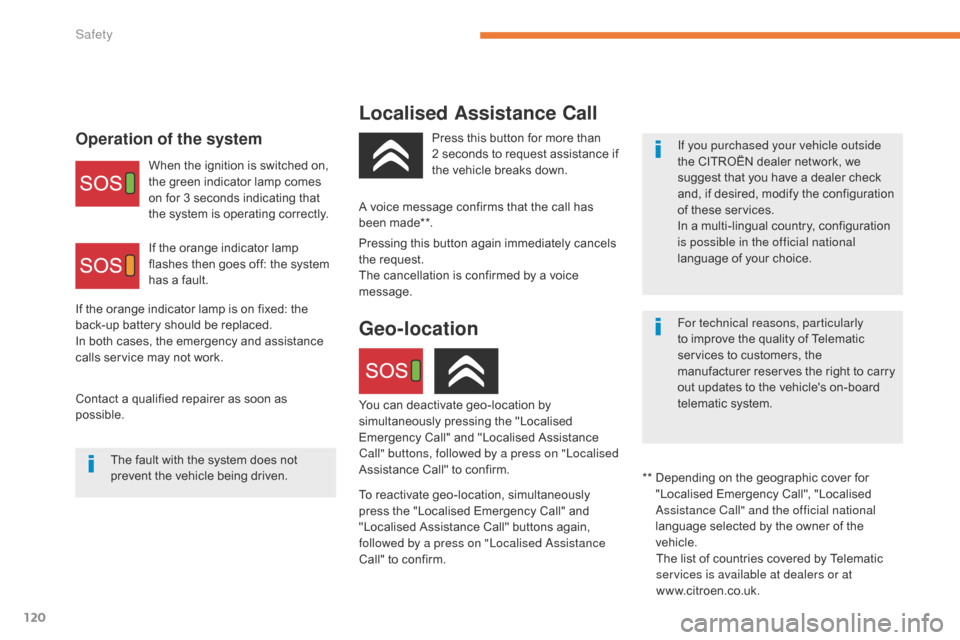
120
B618_en_Chap05_securite_ed01-2016
Localised Assistance Call
Operation of the systemIf you purchased your vehicle outside
the CITROËN dealer network, we
suggest that you have a dealer check
and, if desired, modify the configuration
of these services.
In a multi-lingual country, configuration
is possible in the official national
language of your choice.
For technical reasons, particularly
to improve the quality of Telematic
services to customers, the
manufacturer reserves the right to carry
out updates to the vehicle's on-board
telematic system.
When the ignition is switched on,
the green indicator lamp comes
on for 3 seconds indicating that
the system is operating correctly.
If the orange indicator lamp
flashes then goes off: the system
has a fault.
The fault with the system does not
prevent the vehicle being driven. Press this button for more than
2
seconds to request assistance if
the vehicle breaks down.
**
D
epending on the geographic cover for
"Localised Emergency Call", "Localised
Assistance Call" and the official national
language selected by the owner of the
vehicle. The list of countries covered by Telematic
services is available at dealers or at
www.citroen.co.uk.
Pressing this button again immediately cancels
the request.
The cancellation is confirmed by a voice
message.
Geo-location
You can deactivate geo-location by
simultaneously pressing the "Localised
Emergency Call" and "Localised Assistance
Call" buttons, followed by a press on "Localised
Assistance Call" to confirm.
To reactivate geo-location, simultaneously
press the "Localised Emergency Call" and
"Localised Assistance Call" buttons again,
followed by a press on "Localised Assistance
Call" to confirm.
Contact a qualified repairer as soon as
possible. If the orange indicator lamp is on fixed: the
back-up battery should be replaced.
In both cases, the emergency and assistance
calls service may not work.
A voice message confirms that the call has
been made**.
Safety
Page 123 of 450
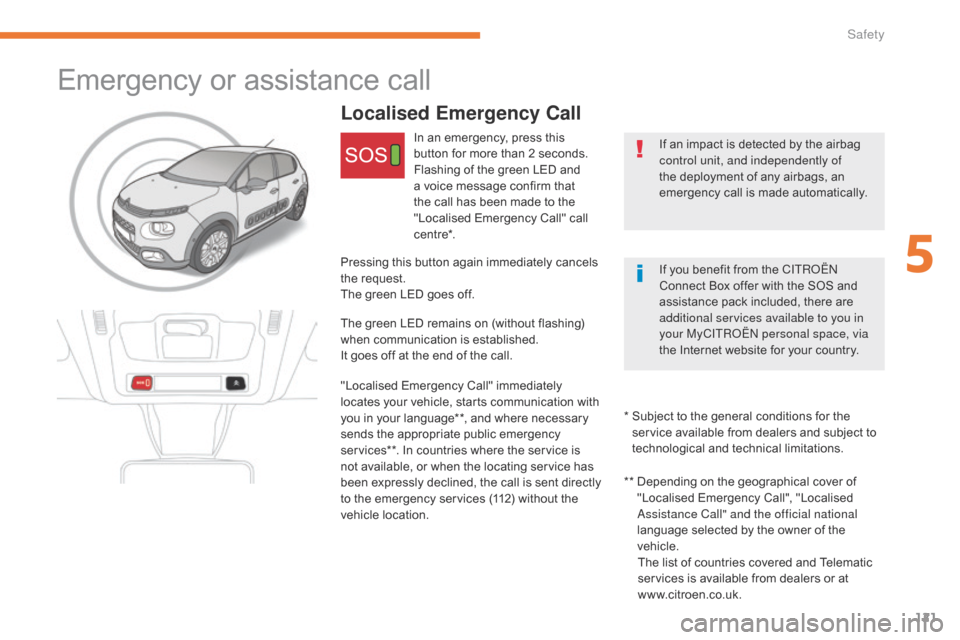
121
B618_en_Chap05_securite_ed01-2016
Localised Emergency Call
If an impact is detected by the airbag
control unit, and independently of
the deployment of any airbags, an
emergency call is made automatically.
If you benefit from the CITROËN
C
onnect Box offer with the SOS and
assistance pack included, there are
additional services available to you in
your MyCITROËN personal space, via
the Internet website for your country.
In an emergency, press this
button for more than 2 seconds.
Flashing of the green LED and
a voice message confirm that
the call has been made to the
"Localised Emergency Call" call
c e nt re*.
The green LED remains on (without flashing)
when communication is established.
It goes off at the end of the call. Pressing this button again immediately cancels
the request.
The green LED goes off.
"Localised Emergency Call" immediately
locates your vehicle, starts communication with
you in your language**, and where necessary
sends the appropriate public emergency
services**. In countries where the service is
not available, or when the locating service has
been expressly declined, the call is sent directly
to the emergency services (112) without the
vehicle location. *
S
ubject to the general conditions for the
service available from dealers and subject to
technological and technical limitations.
**
D
epending on the geographical cover of
"Localised Emergency Call", "Localised
Assistance Call" and the official national
language selected by the owner of the
vehicle. The list of countries covered and Telematic
services is available from dealers or at
www.citroen.co.uk.
Emergency or assistance call
5
Safety
Page 124 of 450
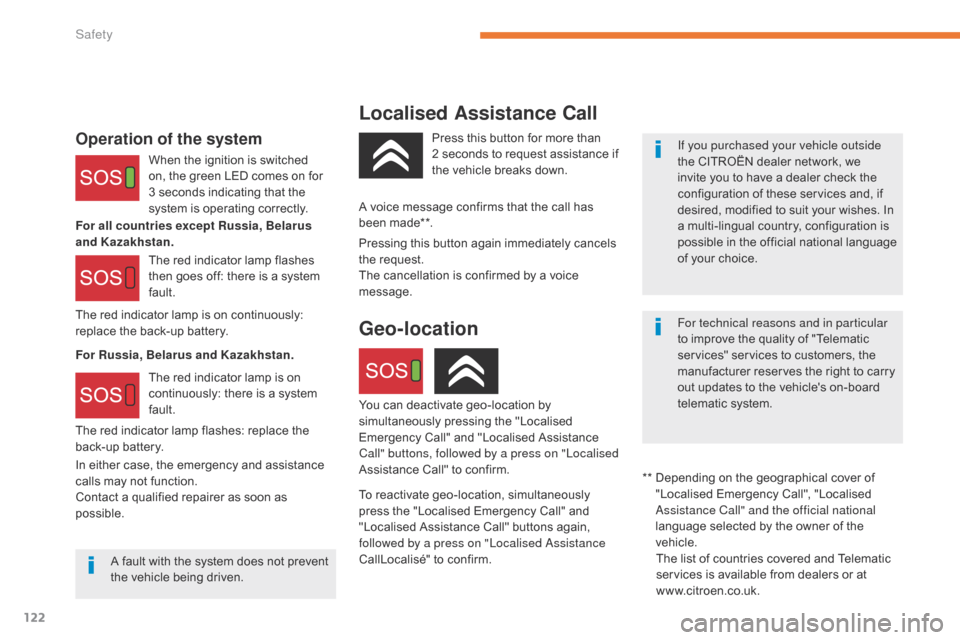
122
B618_en_Chap05_securite_ed01-2016
Localised Assistance Call
Operation of the systemIf you purchased your vehicle outside
the CITROËN dealer network, we
invite you to have a dealer check the
configuration of these services and, if
desired, modified to suit your wishes. In
a multi-lingual country, configuration is
possible in the official national language
of your choice.
For technical reasons and in particular
to improve the quality of "Telematic
services" services to customers, the
manufacturer reserves the right to carry
out updates to the vehicle's on-board
telematic system.
When the ignition is switched
on, the green LED comes on for
3 seconds indicating that the
system is operating correctly.
The red indicator lamp flashes
then goes off: there is a system
fault.
The red indicator lamp is on
continuously: there is a system
fault.
A fault with the system does not prevent
the vehicle being driven. Press this button for more than
2
seconds to request assistance if
the vehicle breaks down.
**
D
epending on the geographical cover of
"Localised Emergency Call", "Localised
Assistance Call" and the official national
language selected by the owner of the
vehicle. The list of countries covered and Telematic
services is available from dealers or at
www.citroen.co.uk.
Pressing this button again immediately cancels
the request.
The cancellation is confirmed by a voice
message.
Geo-location
You can deactivate geo-location by
simultaneously pressing the "Localised
Emergency Call" and "Localised Assistance
Call" buttons, followed by a press on "Localised
Assistance Call" to confirm.
To reactivate geo-location, simultaneously
press the "Localised Emergency Call" and
"Localised Assistance Call" buttons again,
followed by a press on "Localised Assistance
CallLocalisé" to confirm.
The red indicator lamp is on continuously:
replace the back-up battery.
The red indicator lamp flashes: replace the
back-up battery.
A voice message confirms that the call has
been made**.
In either case, the emergency and assistance
calls may not function.
Contact a qualified repairer as soon as
possible. For Russia, Belarus and Kazakhstan. For all countries except Russia, Belarus
and Kazakhstan.
Safety
Page 125 of 450
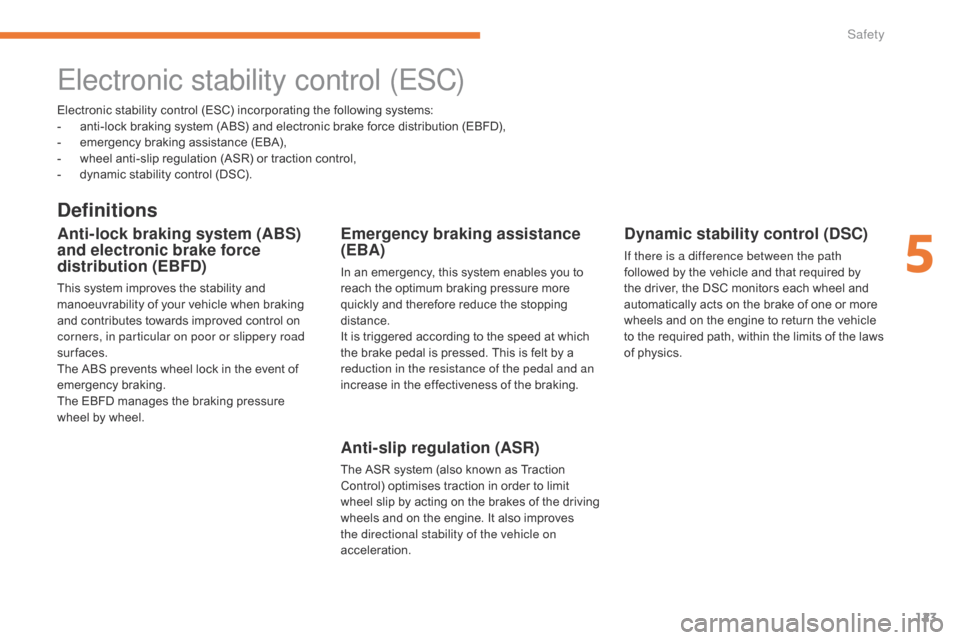
123
B618_en_Chap05_securite_ed01-2016
Electronic stability control (ESC) incorporating the following systems:
- a nti-lock braking system (ABS) and electronic brake force distribution (EBFD),
-
e
mergency braking assistance (EBA),
-
w
heel anti-slip regulation (ASR) or traction control,
-
d
ynamic stability control (DSC).
Electronic stability control (ESC)
Definitions
Anti-lock braking system (ABS)
and electronic brake force
distribution (EBFD)
This system improves the stability and
manoeuvrability of your vehicle when braking
and contributes towards improved control on
corners, in particular on poor or slippery road
surfaces.
The ABS prevents wheel lock in the event of
emergency braking.
The EBFD manages the braking pressure
wheel by wheel.
Emergency braking assistance
(EBA)
In an emergency, this system enables you to
reach the optimum braking pressure more
quickly and therefore reduce the stopping
distance.
It is triggered according to the speed at which
the brake pedal is pressed. This is felt by a
reduction in the resistance of the pedal and an
increase in the effectiveness of the braking.
Anti-slip regulation (ASR)
The ASR system (also known as Traction
Control) optimises traction in order to limit
wheel slip by acting on the brakes of the driving
wheels and on the engine. It also improves
the directional stability of the vehicle on
acceleration.
Dynamic stability control (DSC)
If there is a difference between the path
followed by the vehicle and that required by
the driver, the DSC monitors each wheel and
automatically acts on the brake of one or more
wheels and on the engine to return the vehicle
to the required path, within the limits of the laws
of physics.
5
Safety
Page 126 of 450
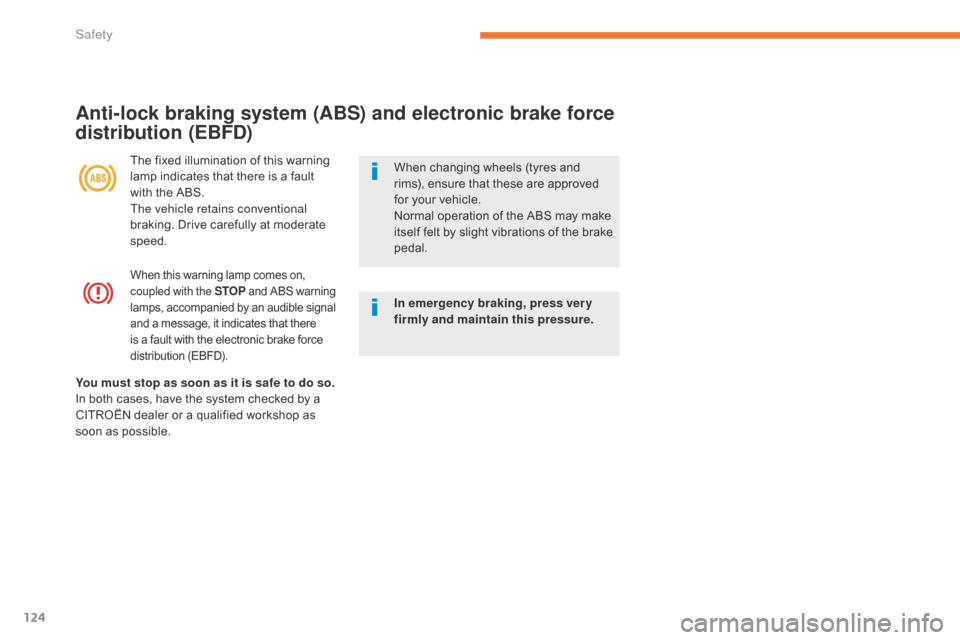
124
B618_en_Chap05_securite_ed01-2016
When this warning lamp comes on,
coupled with the STOP and ABS warning
lamps, accompanied by an audible signal
and a message, it indicates that there
is a fault with the electronic brake force
distribution (EBFD).
Anti-lock braking system (ABS) and electronic brake force
distribution (EBFD)
The fixed illumination of this warning
lamp indicates that there is a fault
with the ABS.
The vehicle retains conventional
braking. Drive carefully at moderate
speed. When changing wheels (tyres and
rims), ensure that these are approved
for your vehicle.
Normal operation of the ABS may make
itself felt by slight vibrations of the brake
pedal.
In emergency braking, press ver y
firmly and maintain this pressure.
You must stop as soon as it is safe to do so.
In both cases, have the system checked by a
CITROËN dealer or a qualified workshop as
soon as possible.
Safety
Page 127 of 450
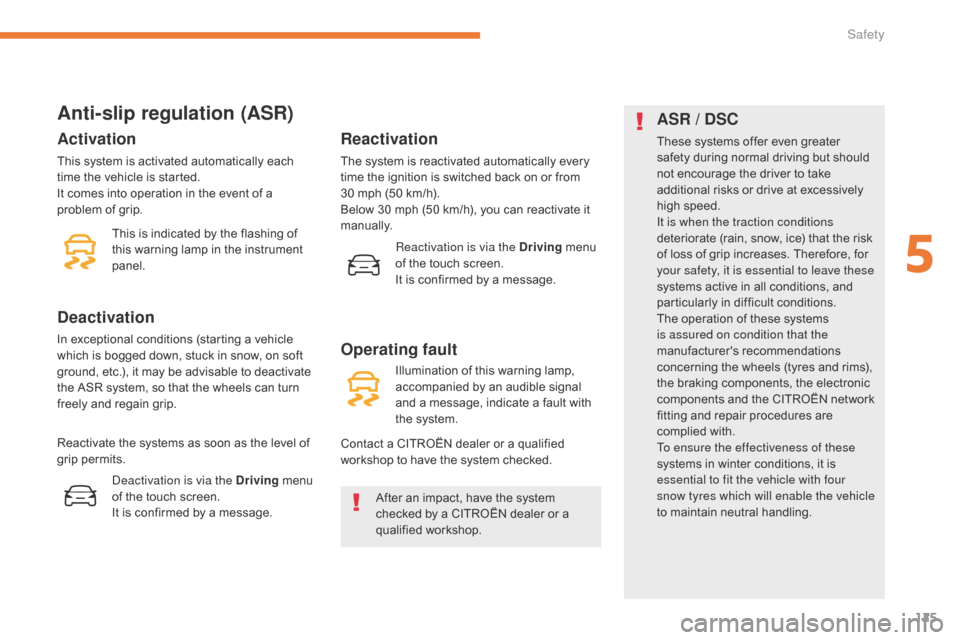
125
B618_en_Chap05_securite_ed01-2016
Anti-slip regulation (ASR)
After an impact, have the system
checked by a CITROËN dealer or a
qualified workshop.
Activation
This system is activated automatically each
time the vehicle is started.
It comes into operation in the event of a
problem of grip.
Deactivation
In exceptional conditions (starting a vehicle
which is bogged down, stuck in snow, on soft
ground, etc.), it may be advisable to deactivate
the ASR system, so that the wheels can turn
freely and regain grip.This is indicated by the flashing of
this warning lamp in the instrument
panel.Operating fault
Reactivate the systems as soon as the level of
grip permits.
Deactivation is via the Driving menu
of the touch screen.
It is confirmed by a message.
Reactivation
The system is reactivated automatically every
time the ignition is switched back on or from
30
mph (50 km/h).
Below 30 mph (50 km/h), you can reactivate it
manually.
Reactivation is via the Driving menu
of the touch screen.
It is confirmed by a message.
Illumination of this warning lamp,
accompanied by an audible signal
and a message, indicate a fault with
the system.
Contact a CITROËN dealer or a qualified
workshop to have the system checked.
ASR / DSC
These systems offer even greater
safety during normal driving but should
not encourage the driver to take
additional risks or drive at excessively
high speed.
It is when the traction conditions
deteriorate (rain, snow, ice) that the risk
of loss of grip increases. Therefore, for
your safety, it is essential to leave these
systems active in all conditions, and
particularly in difficult conditions.
The operation of these systems
is assured on condition that the
manufacturer's recommendations
concerning the wheels (tyres and rims),
the braking components, the electronic
components and the CITROËN network
fitting and repair procedures are
complied with.
To ensure the effectiveness of these
systems in winter conditions, it is
essential to fit the vehicle with four
snow tyres which will enable the vehicle
to maintain neutral handling.
5
Safety
Page 128 of 450
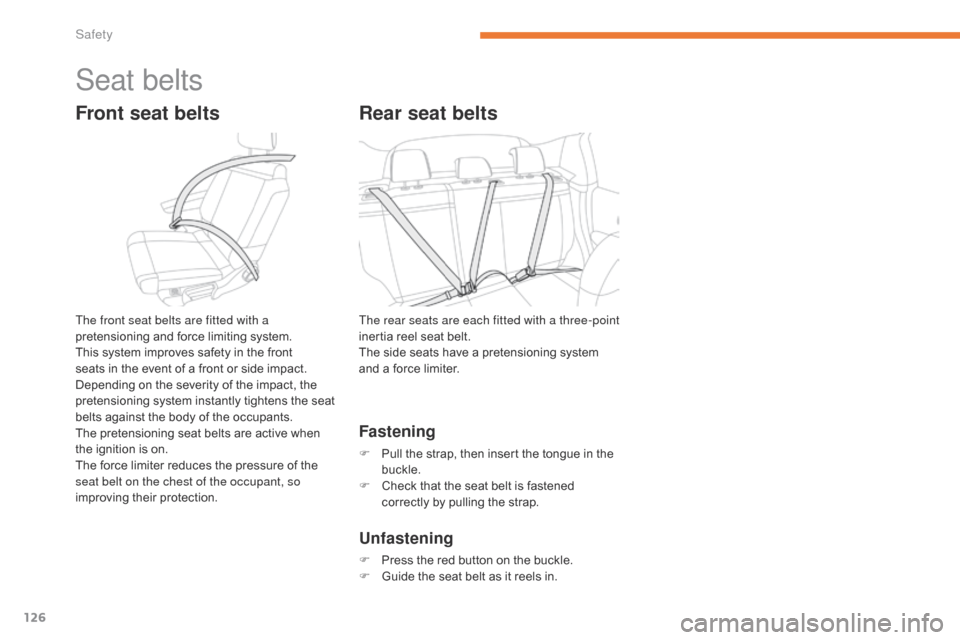
126
B618_en_Chap05_securite_ed01-2016
Seat belts
Front seat belts
The front seat belts are fitted with a
pretensioning and force limiting system.
This system improves safety in the front
seats in the event of a front or side impact.
Depending on the severity of the impact, the
pretensioning system instantly tightens the seat
belts against the body of the occupants.
The pretensioning seat belts are active when
the ignition is on.
The force limiter reduces the pressure of the
seat belt on the chest of the occupant, so
improving their protection.
Fastening
F Pull the strap, then insert the tongue in the buckle.
F
C
heck that the seat belt is fastened
correctly by pulling the strap.
Unfastening
F Press the red button on the buckle.
F G uide the seat belt as it reels in.
Rear seat belts
The rear seats are each fitted with a three-point
inertia reel seat belt.
The side seats have a pretensioning system
and a force limiter.
Safety
Page 129 of 450
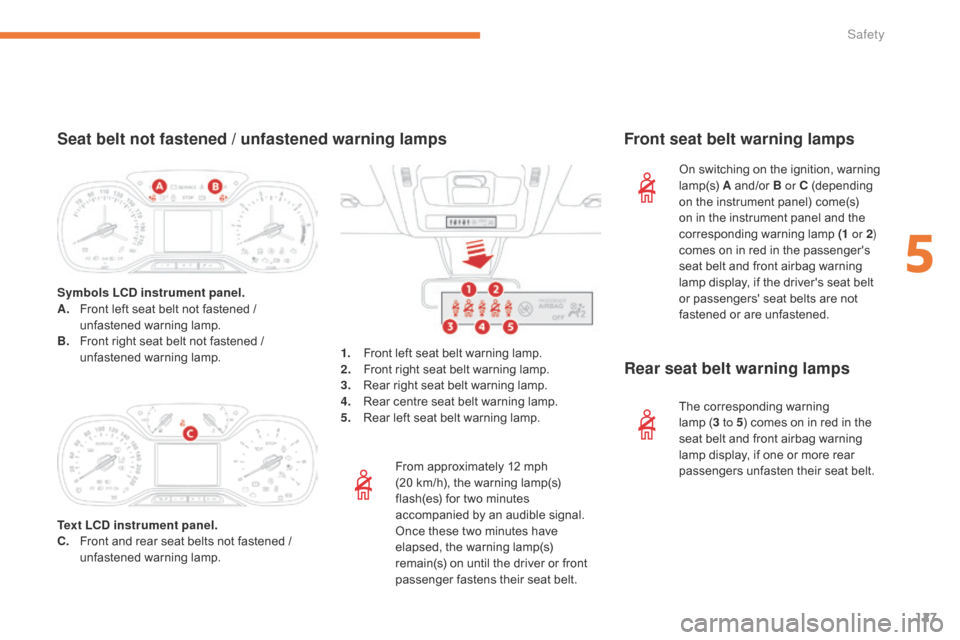
127
B618_en_Chap05_securite_ed01-2016
From approximately 12 mph
(20 km/h), the warning lamp(s)
flash(es) for two minutes
accompanied by an audible signal.
Once these two minutes have
elapsed, the warning lamp(s)
remain(s) on until the driver or front
passenger fastens their seat belt.
Seat belt not fastened / unfastened warning lamps Front seat belt warning lamps
On switching on the ignition, warning
lamp(s) A and/or B or C (depending
on the instrument panel) come(s)
on in the instrument panel and the
corresponding warning lamp (1 or 2 )
comes on in red in the passenger's
seat belt and front airbag warning
lamp display, if the driver's seat belt
or passengers' seat belts are not
fastened or are unfastened.
Symbols LCD instrument panel.
A.
F
ront left seat belt not fastened /
unfastened warning lamp.
B.
F
ront right seat belt not fastened /
unfastened warning lamp.
Rear seat belt warning lamps
The corresponding warning
lamp (3 to 5 ) comes on in red in the
seat belt and front airbag warning
lamp display, if one or more rear
passengers unfasten their seat belt.
1.
F
ront left seat belt warning lamp.
2.
F
ront right seat belt warning lamp.
3.
R
ear right seat belt warning lamp.
4. R
ear centre seat belt warning lamp.
5. R
ear left seat belt warning lamp.
Text LCD instrument panel.
C.
F
ront and rear seat belts not fastened /
unfastened warning lamp.
5
Safety
Page 130 of 450
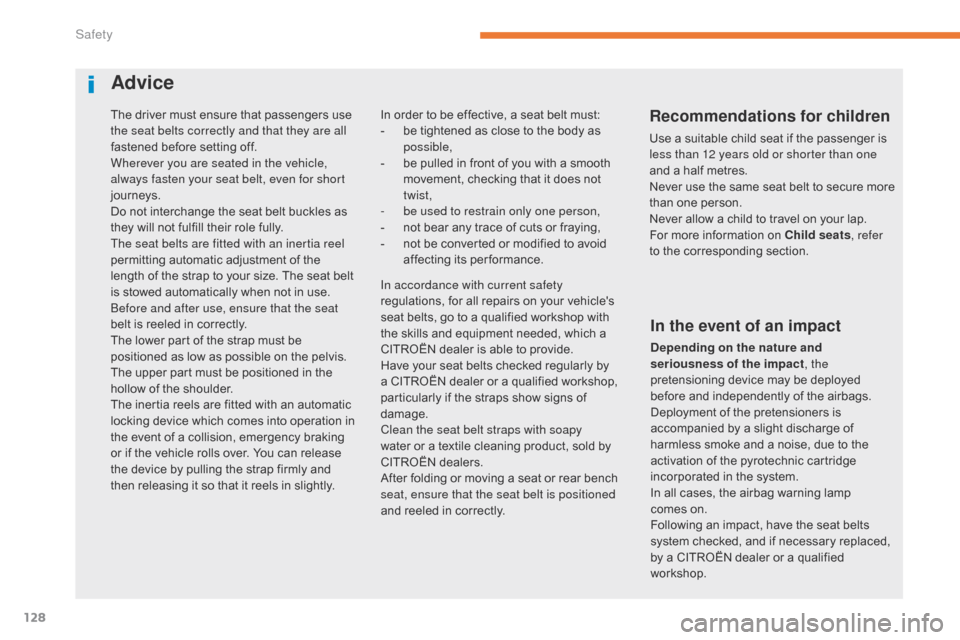
128
B618_en_Chap05_securite_ed01-2016
The driver must ensure that passengers use
the seat belts correctly and that they are all
fastened before setting off.
Wherever you are seated in the vehicle,
always fasten your seat belt, even for short
journeys.
Do not interchange the seat belt buckles as
they will not fulfill their role fully.
The seat belts are fitted with an inertia reel
permitting automatic adjustment of the
length of the strap to your size. The seat belt
is stowed automatically when not in use.
Before and after use, ensure that the seat
belt is reeled in correctly.
The lower part of the strap must be
positioned as low as possible on the pelvis.
The upper part must be positioned in the
hollow of the shoulder.
The inertia reels are fitted with an automatic
locking device which comes into operation in
the event of a collision, emergency braking
or if the vehicle rolls over. You can release
the device by pulling the strap firmly and
then releasing it so that it reels in slightly.
In the event of an impact
Depending on the nature and
seriousness of the impact, the
pretensioning device may be deployed
before and independently of the airbags.
Deployment of the pretensioners is
accompanied by a slight discharge of
harmless smoke and a noise, due to the
activation of the pyrotechnic cartridge
incorporated in the system.
In all cases, the airbag warning lamp
comes
on.
Following an impact, have the seat belts
system checked, and if necessary replaced,
by a CITROËN dealer or a qualified
workshop.
In order to be effective, a seat belt must:
-
b
e tightened as close to the body as
possible,
-
b
e pulled in front of you with a smooth
movement, checking that it does not
twist,
-
b
e used to restrain only one person,
-
n
ot bear any trace of cuts or fraying,
-
n
ot be converted or modified to avoid
affecting its performance.
Recommendations for children
Use a suitable child seat if the passenger is
less than 12 years old or shorter than one
and a half metres.
Never use the same seat belt to secure more
than one person.
Never allow a child to travel on your lap.
For more information on Child seats , refer
to the corresponding section.
In accordance with current safety
regulations, for all repairs on your vehicle's
seat belts, go to a qualified workshop with
the skills and equipment needed, which a
CITROËN dealer is able to provide.
Have your seat belts checked regularly by
a CITROËN dealer or a qualified workshop,
particularly if the straps show signs of
damage.
Clean the seat belt straps with soapy
water or a textile cleaning product, sold by
CITROËN dealers.
After folding or moving a seat or rear bench
seat, ensure that the seat belt is positioned
and reeled in correctly.
Advice
Safety